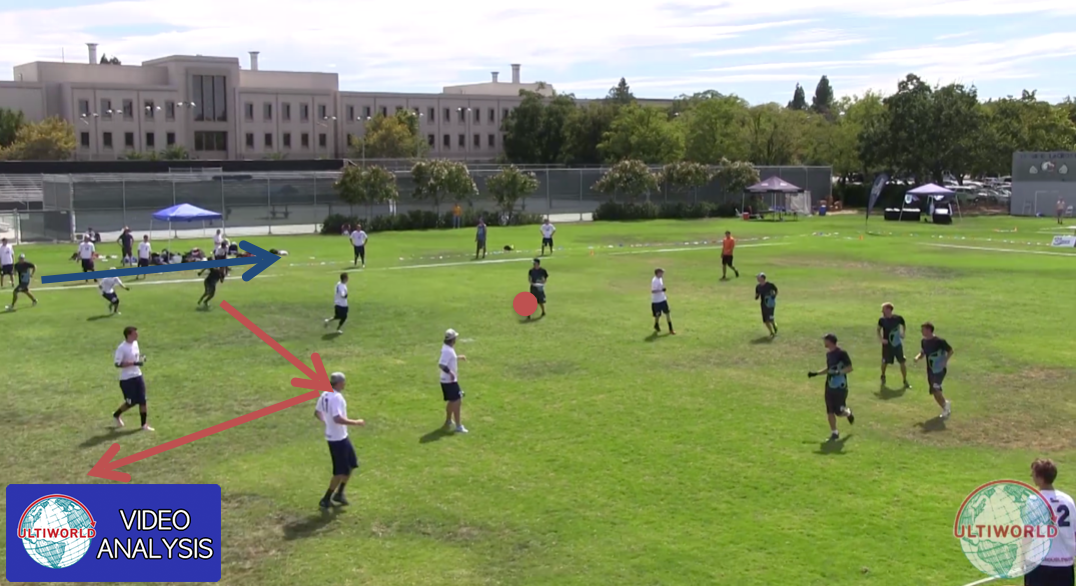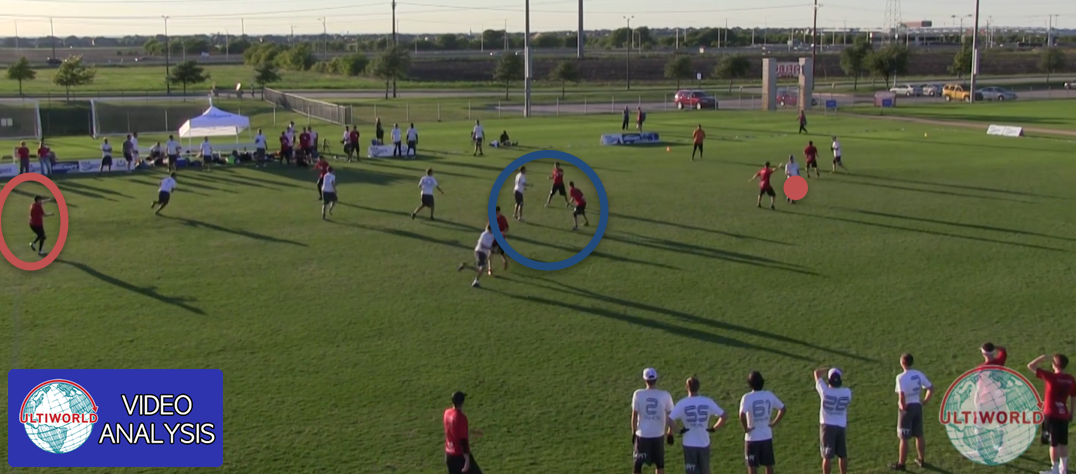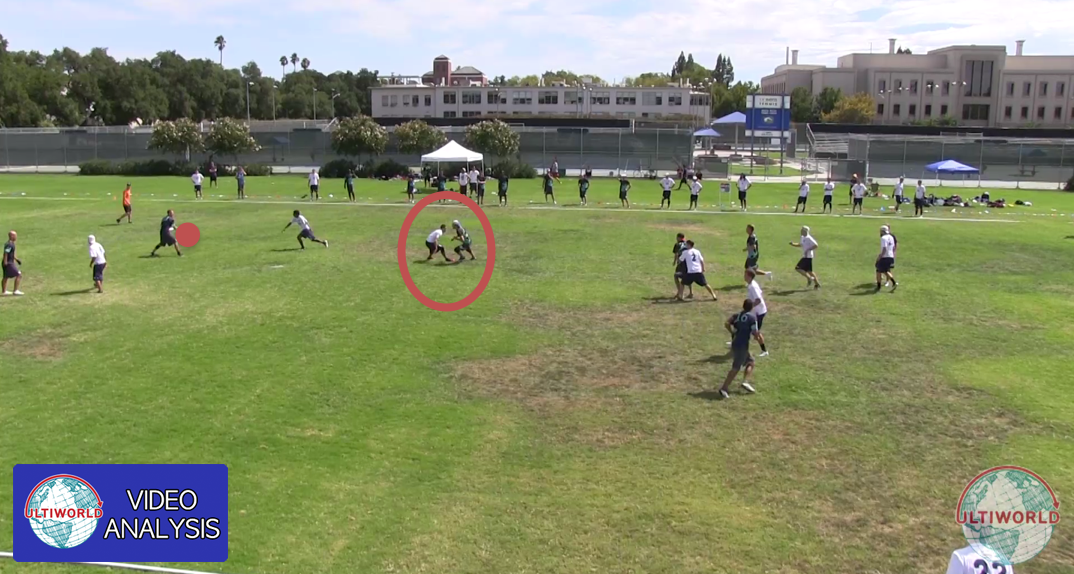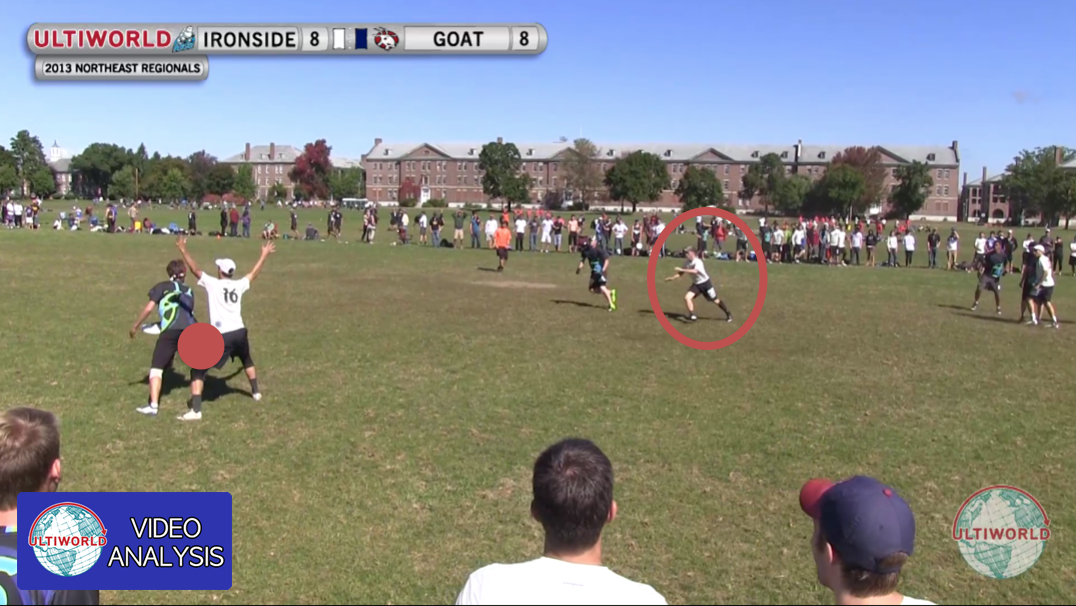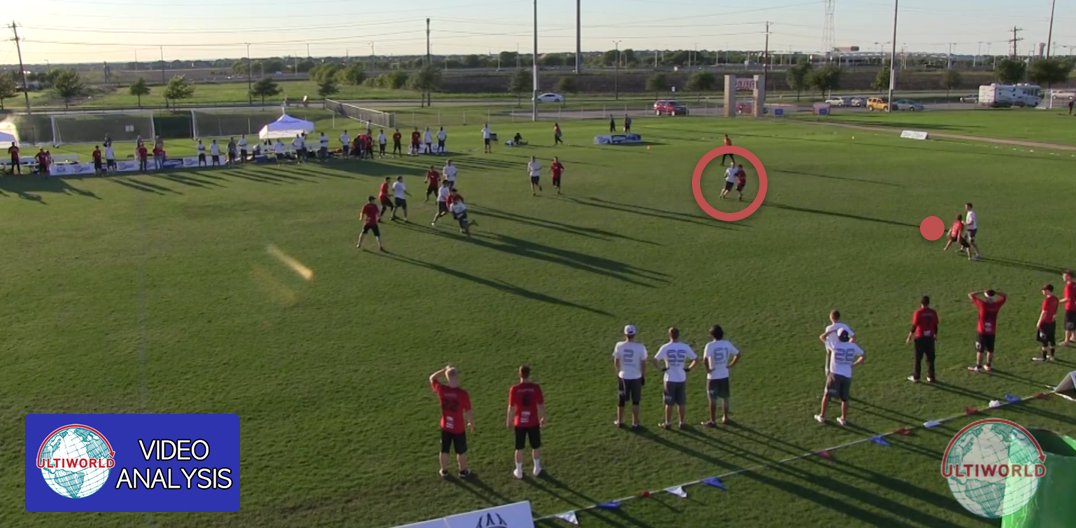Toronto GOAT was one of the most exciting stories of the 2013 regular season. But their storybook year got ended early at Nationals when they struggled all weekend. Joseph Marmerstein digs into the tape to figure out what went wrong.
July 17, 2014 by Joseph Marmerstein and Sean Childers in Analysis with 5 comments
Why did GOAT do so well during the toughest part of the 2013 Club Ultimate season, only to perform so poorly at the Club Championships?
Of course, everyone has their theories – “peaking too early”, burning out after a long season playing in the AUDL and Triple Crown Tour, other teams scouting them, or simply succumbing to the pressure of high expectations.
Most theories are probably valid to some degree, but we’ve moved beyond the theory-only age of Ultimate; we’re in the video age.
Using available game tape, we can identify GOAT’s strengths and successful opponent adjustments by breaking down three of the biggest games from GOAT’s season – their wins in the finals at the Pro Flight Finale and Northeast regionals (against Doublewide and Ironside, respectively), and their loss against Sockeye in pool play at Nationals.
Doublewide Failed To Stop GOAT’s Pull Plays
Against Doublewide at the Pro Flight Finale, GOAT excelled with their pull plays, often scoring within 5 throws — especially important when playing with a small roster.
Toronto often runs a 3-2 split stack off the pull, using a couple of plays to generate some easy underneath looks to start their offensive movement.
The 3-2 offense is an effective setup that gives star players (usually the cutters in the “two” side of the stack) ample amounts of space to be dangerous in. Defenses who play super honest (pure one-on-one) man will likely fail against a well-designed 3-2 split stack play, which generally creates at least one – and often two – good cuts in open-side and middle of the field space.
Generally, when GOAT was able to hit those early set looks and move the disc in the framework of their set play, they were successful.
The screenshot above, and the clips below, show some of GOAT’s main plays out of their 3-2 split stack. In the first, Karl Loiseau clears across the field and breaks deep, giving Andrew Ouchterlony an easy under on the far sideline. Loiseau is then able to use the space he has created deep to catch a huge gainer, and GOAT is able to easily work it up the far side before throwing an easy dump and swing for the score. At other points in this game against Doublewide they are able to score with similar ease when faced with a standard man-to-man defense.
If the first underneath look (Ouchterlony in the screenshot/first clip) is not open, he clears out across the field and deep, allowing the first cutter, Loiseau in this case, to come back under for another option. GOAT can be seen executing this in the second clip below.
Ironside Showed Better Defense, But Couldn’t Contain Handlers
Ironside did a better job of containing GOAT’s pull plays. Although GOAT still got open on the first cut most times, Ironside cut off the continuation with aggressive marking and downfield defense. The mark shifts to a more flat force, pressuring upfield throws – challenging hucks and in-cuts that go up the same angle.
At the same time, the downfield defenders put more pressure on the next in-cut, knowing that deeper throws would be difficult because of the mark. This approach gives up easy swings, but effectively shuts keeps the second-under window small – usually resulting in GOAT looking off those continuation cuts that gave them so much at the Pro Flight Finale and dumping the disc instead.
GOAT had considerably less success when their plays broke down: below are a few examples of Ironside containing the play and forcing tough throws or turnovers as a result.
Ironside Containing GOAT at Regionals 1
Ironside Containing GOAT at Regionals 2
Ironside Containing GOAT at Regionals 3
In the last clip above, GOAT hits the continuation and starts moving the disc down the field quickly – but even here, Ironside’s tight, flat mark forces the second under cut to be for a 5 yard gain, rather than 20 yards. It looks as though Ironside had studied the game film and came in with a deliberate plan to contest upfield continuation, even at the price of giving up some around breaks.
Sockeye Was Most Ready
At Nationals, Sockeye came even more prepared, and was able to slow down GOAT’s pull plays using different tactics than Ironside. Sockeye made GOAT work much harder to score, mainly by poaching, using a clam-like approach, and switching early in the defensive point.
The screenshot below shows the poachy defense Sockeye (in red) used to stop the GOAT pull plays and slow down their offense.
We can see Seattle double-teaming the front of the stack, and leaving one defender to cover the deep space. The result is that GOAT ends up throwing a heavily pressured dump pass to Alexander.
Other clips also show how well Sockeye poaches and switches to shut down the primary option of the GOAT offense. On a couple of occasions, GOAT looks to run a play, but stops once they recognize that Sockeye is in a zone.
Yes, you can criticize GOAT’s handlers for not finding — and hitting — players in open space in those clips. But doing so sells Sockeye’s preparation short. Anyone who watched the games earlier in the season would have noticed that GOAT’s main handler (often Alexander) and their two side stack cutters were the primary options in open space. Other cutters were looking to fill. Sockeye junked up the big space while sitting a bit underneath downfield GOAT cutters that played more of the fill roles. Players were open, but not in the space GOAT was necessarily expecting.
Even more interestingly, by the time GOAT did recognize that Sockeye was playing zone and threw a pass or two, Sockeye had already transitioned into man, and effectively stopped any quick-scoring pull play GOAT wanted to run. Sockeye got some of the pull-play busting benefits from playing zone, even though they didn’t necessarily trust that it was their best option for the course of an entire point.
Anecdotally, there’s evidence that scouting of the pull plays made a difference. Sockeye said that the amount of Ultiworld club video available last year changed the way they prepared for the Club Championships.
GOAT coach Scott Hastie told Ultiworld that the nature of video work is changing the way elite teams are playing. “It used to be: ‘Hey great there is video of our game. Maybe our friends and family can check it out,’” Hastie told Ultiworld. “Now opposing coaches are watching our videos? Who knew? Sockeye coach Roger Crafts even said to me at one point in Frisco, ‘I think you guys were well scouted this year.’ We have learned to be wary of cameras.”
GOAT 2013 tended to combine systemic downfield cutting with more impromptu handling. A team that melds man and zone defensive looks together – like Sockeye – may have been a good counter to that setup. Note in the last clip below, Sockeye decided to come out in a straight man-to-man, and GOAT made quick work of it. Sockeye would not make this mistake again for the rest of the game.
It is interesting to note the very different approaches taken by Sockeye and Ironside to stop GOAT’s pull plays. Sockeye relies on poaching and switching early in the point, while Ironside plays a stricter man-to-man, relying on tighter defense and marking adjustments to stop continuation cuts. Sockeye’s approach works better in these examples, but is much more difficult and requires more preparation and chemistry. In particular, they were able to transition out of poaches and into man very smoothly – something that GOAT themselves might notice in video and successfully adjust to when the two teams meet next.
Sockeye Also Pressured Resets
When their plays break down, GOAT transitions into a tight vertical stack that gives a lot of room for handler movement – they are very willing to work the disc up the field with short 5-10 yard throws under tight defensive pressure. Once again, this reflects more of a free flowing backfield structure; once GOAT decides to play with the disc in the backfield, the idea is to leave that space for the handlers to make magic happen.
Below we can see how GOAT spaces their vertical stack, giving the front of the stack and the thrower a lot of space to work with (the disc is marked with a red dot, and the front of the stack circled).
By pushing their stack back and leaving lots of isolation space for a third handler (or midplayer, like Lloyd), GOAT has made it tougher to huck from a standstill position—their stack is very deep. But the upside is that they’ve created an almost endzone-like isolation situation between two or three of their top players.
That’s especially dangerous, because one of GOAT’s biggest strengths offensively is moving the disc using short space throws in the handle-set. They are content to run almost exclusively through Mark Lloyd, Derek Alexander, Adrian Yearwood, Anatoly Vasilyev, and others. They slowly chew up yards with quick passes and creative breaks – check out this clip from Northeast Regionals where a GOAT runs a mini-like offense — at one point, a cutter doesn’t touch the disc for 8 throws.
Sockeye knew this coming into Nationals, and when playing man, did a great job of forcing the GOAT handlers upfield and forcing tougher throws into small windows. In the three screenshots below, we can see the difference between how Doublewide, Ironside, and Sockeye played against the dump handler.
In the first picture (above), we see that Doublewide (in white) plays almost 10 yards off the reset handler, Alexander, a player that GOAT wants to have a lot of touches. Although they put on more pressure at certain points, on the whole the GOAT offense was able to get easy resets all game. That sagging positioning in the lanes works well against some teams who are stubborn about moving the disc through larger, up-field throwing lanes. It works less well against GOAT, who’s handlers are excellent at beating a poach using 15 passes — gaining a few yards and just a bit of momentum each time.
In the second picture (below), we see that Ironside (in white) plays a little closer on the dump than Doublewide did. Here, the Ironside defender is in a position to make a play if the throw is poor. It also reflects the standard, middle-ground approach to reset defense: Don’t poach into the lanes so much that you give up easy, uncontested resets. But be careful about fronting, because it might let the handler open upline.
Despite the increased pressure, the GOAT handlers were still able to get open consistently, sometimes working it up the field for 10+ throws without ever throwing to a cutter. GOAT’s handlers simply played so well in that game that they were still able to capitalize on the small open windows.
In the final picture below, we can see how Sockeye (in red) forces Alexander upfield, playing physical and aggressive on the dump. In the first few points of the game, Alexander was fouled away form the disc twice.
Although GOAT is still able to get resets early in the game, they are heavily pressured, and later in the game they are forced to take tougher looks downfield when the dumps are not open. Sometimes GOAT was able to hit this tough inside-window anyways, but othertimes there were rushed passes or drops that primarily resulted from Sockeye’s tough, tight, fronting position. It seemed that, on the balance, Sockeye was willing to give up some upline beats if it meant the average handler cut was a difficult journey for GOAT.
Expect GOAT to adjust in part by simply looking to execute better when facing a handler front: more reps in practice, more of the same looks from opponents, and practice throwing the tight inside flick or lefty backhand. One can see how no single theory of GOAT’s 2013 performance explains everything — yes, Sockeye scouted well-enough to force some adjustments, but GOAT’s below-average execution (by their standards) gave up possession.
There are other positional adjustments available to try and counter this sort of fronting. In the screenshot above, you can see Alexander attempting to push his man backfield to then create as large of a throwing window upfield as possible — minimizing the difficulty of the upfield pass. The drive from Alexander is smart here, but he could have made it even easier by setting up a few yards even further in the backfield. Another (albeit riskier option) is to set up even closer to the thrower and open up a throwing window into the tons of open space behind both the reset and reset defender. A dump defender that fronts his man wants as much time as possible to react to a throw that goes up — staying too far away only plays to that advantage.
Notes:
- At the Pro Flight Finale, GOAT had a small roster. As a result, they tried to play more “team defense”, poaching and looking for switches to save their energy. At regionals and nationals, with a full squad, they tended to play more honest – maybe having a short roster actually helped them.
- GOAT had a lot of trouble containing Matt Rehder in the first half of their game against Sockeye. In his first six points on the field, Rehder scored 5 goals. They did a good job against Doublewide of stopping athletes like Will Driscoll and Tyler Degirolamo, but could not repeat the performance against Seattle. I’m not entirely sure why, but its possible Sockeye horizontal stack and general field spacing made it harder for defenders to help onto Rehder.
